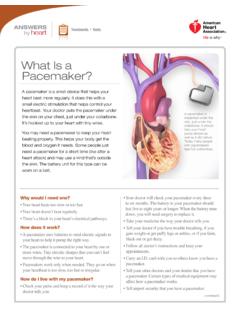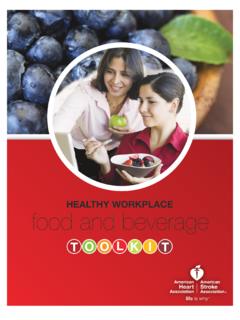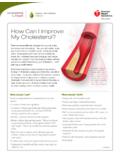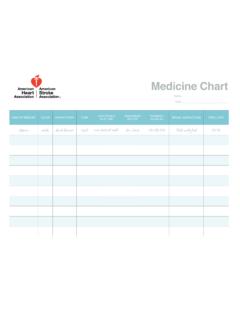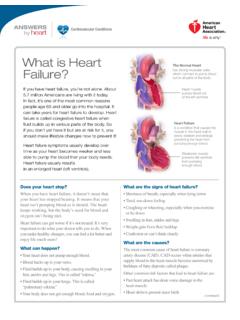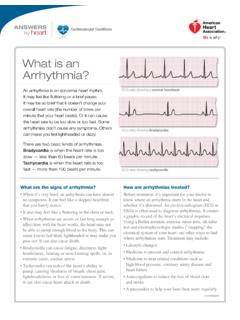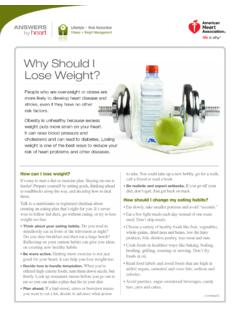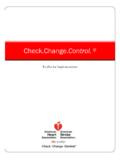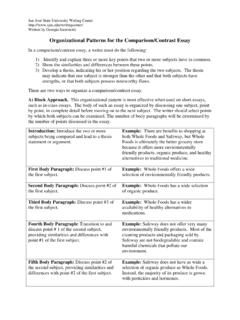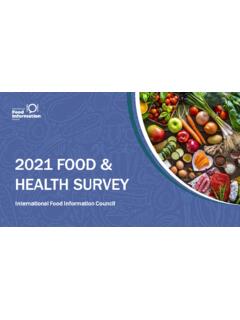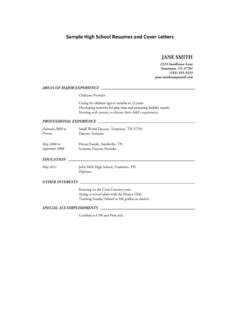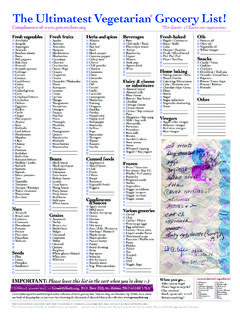Transcription of Inside this Guide
1 Inside this Guide :Bank on the Basics ..1 Create Your Food Budget ..1 About SNAP ..2 healthy Eating Recommendations ..2 Planning Your Meals ..3 Keep a Well-Stocked Pantry ..5 When You Shop ..6 Know Your Labels and Dates ..6 Grocery List Template ..8 Shop Smart on a BudgetBank on the Basics The average American family spends about $150 a week on groceries . As food prices keep rising, smart shopping (for good nutrition on a budget) becomes more challenging. Smart shopping means knowing what to buy and when. The good news is, healthy eating can actually cost less. The key is knowing the basics before you go grocery shopping. Your goal is to choose foods that will help family members stay healthy without high cost. That means finding affordable foods that offer good nutrition. You also want foods that are lower in sodium and not too high in calories. By creating a food budget, planning menus and shopping wisely, you can save money and enjoy delicious, nutritious meals!By following the tips in this booklet, you will be able to enjoy healthier food at more affordable prices.
2 Happy shopping!Create Your Food BudgetSmart shoppers don t get that way by accident. They take time to educate themselves. Just like you re doing now!To shop smarter, start with your family s food basics and build a budget. Assess your current spending. How much do you spend on food each week? Make sure to include non-perishable foods and other items you need when cooking, like paper and cleaning products. If you eat meals out, include that cost to see your total spending on food. Subtract any food assistance you get. Multiply by 4 to find your monthly food budget. Your family size and the age of family members will affect your budget. If you re not sure what your household food budget is, estimate it using this: Consider how much you spend on food and compare this to your other expenses. Set spending priorities. When you shop, try to stick to your budget so you keep food costs in balance with other your spending each week. Writing down everything will help you budget more accurately.
3 1 About SNAPSNAP stands for Supplemental Nutrition Assistance Program. If you re eligible for these benefits, you can get a variety of healthy foods. Learn more about SNAP: Don t get SNAP now but think you might be eligible? This pre-screening tool will help you learn more: If you can, check your SNAP benefit balance in your state before shopping: you re eligible for SNAP, these are foods you can get for your family to eat: breads and cereals; fruits and vegetables; meats, fish and poultry; dairy products; edible seeds and plants. Your youngest family members may have baby food, including infant formula, cereals, juices and baby food in boxes and Eating RecommendationsThink about your family. How you eat at home can have a big impact on your loved ones health. The American Heart Association s healthy Eating Recommendations are based on a 2,000-calorie diet. They re a good Guide for healthy eating. Here are some tips they include about different types of foods: Balance the number of calories you eat with those you burn.
4 (This means don t eat more calories than you need!) Balancing the calories you consume with what you use will help you maintain a healthy body weight. Eat a diet rich in fruits and vegetables. A typical adult should try to eat 4 to 5 servings of vegetables and 4 to 5 servings of fruits every day (a serving is about 1/2 to 2/3 cup). Fruits and vegetables provide plenty of vitamins, minerals and fiber without too many calories. Variety matters, so try a wide range of fruits and veggies. Choose whole grains and high-fiber foods. (Eat three 1-oz. servings per day.) A diet rich in fiber helps manage your weight. Fiber keeps you feeling fuller longer, so you eat less. Eat fish, especially oily fish like salmon or albacore tuna, twice a week. Oily fish contain omega-3 fatty acids, which help your heart stay healthy . Choose fats wisely. Eat less of the bad fats (saturated and trans fats) and replace them with better fats (monounsaturated and polyunsaturated fats).
5 Choose lean meats; select fat-free (skim), 1 percent and low-fat dairy products; and avoid hydrogenated fats (margarine, shortening, cooking oils and foods made from them). A person who needs 2,000 calories each day should consume less than 16 g saturated fat, less than 2 g trans fat and between 50 and 70 grams of total fat. Those are totals for one day. The daily limit for cholesterol is no more than 300 Smart on a Budget 3 Limit the amount of added sugars you consume. Keep added sugars to no more than half of your daily discretionary calorie allowance. For most American women, this is no more than 100 calories per day. For men the limit is no more than 150 calories per day. (That s about 6 teaspoons/day for women and 9 teaspoons/day for men.) Limit sugar-sweetened beverages to no more than 450 calories (36 oz.) per week. Eating too much sugar can lead to obesity and contribute to diabetes. Limit processed meat to no more than two servings per week. Processed meats include sandwich meat, sausage, bacon and hot dogs.
6 These can be high in sodium and fat. Try to eat four servings a week of nuts, seeds or legumes (beans). These can be good sources of healthy fats, nutrients and/or fiber. Aim to eat less than 1,500 mg of sodium per day. This will help you and your family members maintain a healthy blood pressure. There are many ways to reduce sodium in your diet. Here are just a few suggestions: o Read food labels and choose the product with the lowest amount of sodium you can find in your store. o Look for foods labeled low sodium or no salt added. o Drain and rinse canned vegetables to remove some of the Your MealsCooking at home may seem time-consuming. However, you can save time by being organized and prepared. You can save money, too!Use a calendar, and write in the meals for the week. If you know you ll eat out during the week, note that on the calendar and estimate the cost in your budget. The Simple Cooking with Heart website has almost 100 heart- healthy options that are simple, quick and budget-friendly.
7 It also has videos of many recipes and cooking skills. ( )Keep track of recipes your family likes. Note on the recipes if you had leftovers, and keep those meals in mind for your busiest weeks. Here are some guidelines to use in selecting recipes and making purchases. They ll help you make healthier choices while staying on budget. Check the serving sizes on recipes and the Nutrition Facts labels on boxed or canned foods. Use the suggested serving size when portioning meals. This will help family members get the right amount of calories. It will also make meals go farther. Many recipes make enough servings for leftovers! Using frozen fish and meats can make meal planning quick and easy. Canned tuna is a great source of protein; often you can save money by buying several cans. Be sure to trim fat from meat and remove skin from chicken before cooking. Try a meatless meal each week. Whole grains and beans are great sources of protein. They re often more affordable and may require less work to prepare than meats or seafood.
8 Planning Your Meals (continued) To make meals more fun, create theme nights. o Salad Night: Make your entr e a healthy bowl of greens. Toss in cooked skinless chicken breast pieces, nuts or seeds (with little or no salt) for protein. Use a wide variety of fresh veggies and dark green lettuce. Skip iceberg lettuce; it s lower in nutrients. o Taco Night: Pile on the veggies and use whole-wheat or corn tortillas. Mix a little non-fat or low-fat Greek yogurt and lemon juice to make a healthier version of sour cream. o Homemade Pizza: Make a grilled pizza without cheese by loading veggies and some cooked, diced chicken onto a thin, whole-wheat crust. o Super Spuds: Pour vegetarian chili over baked potatoes for an easy meal. Plan to cook once and eat twice. This will save you money and time while ensuring you use up the foods you buy. You can make a variety of meals by using the same ingredients in different ways. Cook more at home and limit prepared or ready-made foods.
9 They tend to be more expensive. They also usually contain more sugar, salt, fat and preservatives. Often they don t last very long, either. Buy fruits and vegetables in season. Seasonal produce is the freshest and tastiest, and it s more affordable. Carrots, potatoes and greens are versatile, readily-available vegetables. Bananas, grapes, apples and oranges are generally the most affordable fruits year-round. (For the best price, buy them in bulk, but don t buy more than you can use before they spoil.) Many farmers markets accept SNAP see if yours does! o Shop your local farmers market. You ll see the freshest foods and good prices. Looking at the produce will often give you ideas about what to cook. o Make casseroles, soups and other seasonal produce recipes when the ingredients are at their best, then freeze them. This will keep the meal tasting its best and give you a quick dinner on a busy night! Keep your fridge and pantry stocked with frozen and canned fruits and vegetables.
10 They have lots of good nutrients without being too high in calories. Also, they won t spoil. Compare food labels and choose the products with the lowest amount of sodium and added sugars. Package your own healthy snacks. Put cut-up veggies and fruits in portion-sized bags for easy, healthy snacking on the go. Make meals a family affair! Your kids will be more excited about eating when they ve been involved. Teach kitchen basics by giving family members age-appropriate tasks like helping to make lists, cutting coupons, reading labels or unloading groceries . If you re a parent who works late, older children and teens can also help get meals started if you leave basic instructions for them. Clip coupons. Keep circulars and check the front of your local grocery store for coupon displays. Cut out the coupons, and put them in an envelope to keep with you. 4 Shop Smart on a Budget Make a ListBased on your recipes for the week, write down what ingredients you need to buy.
